Physical Address
304 North Cardinal St.
Dorchester Center, MA 02124
This chapter is mainly devoted to immune-mediated kidney disorders, and is primarily focused on glomerular diseases. Lupus nephritis and ANCA-associated vasculitis are addressed in separate chapters. The reader is reminded that the renal involvement may be the initial manifestation of systemic disease, and the results of renal pathology may provide the first clues to diagnosis. In this chapter, glomerular diseases have been divided into diseases that present as either acute glomerulonephritis or the nephrotic syndrome, although there is overlap in these clinical presentations. For example, some patients present with features of both, while diseases that most often present as nephrotic syndrome, sometimes present as acute glomerulonephritis, and vice versa. Nevertheless, we find this distinction to be useful as starting point in the differential diagnosis, although as indicated below, the clinical presentation is dependent on the primary pathophysiologic events that predominate in individual patients.
Keywords
focal segmental glomerulosclerosis, glomerulonephritis, Goodpasture’s syndrome, hemolytic-uremic syndrome, HIV-associated nephropathy, IgA nephropathy, membranoproliferative glomerulonephritis, membranous nephropathy, minimal change disease, nephrotic syndrome, thrombotic thrombocytopenic purpura
Acute glomerulonephritis (AGN) is characterized by the sudden appearance of hematuria, proteinuria, and red blood cell casts, whereas subacute and chronic forms present more indolently. The differential diagnosis is listed in Table 82.1 . This discussion will include consideration of the incidence, pathogenesis, pathology, clinical presentation, prognosis and treatment, with emphasis on primary forms of the syndrome, including acute post-infectious GN, idiopathic membranoproliferative glomerulonephritis (MPGN) anti-glomerular basement membrane (GBM) disease and IgA nephropathy. Thrombotic microangiopathies will be discussed briefly, since its clinical presentation often mimics that of AGN. Our main focus is on human forms of the disease, and neither the differential diagnosis nor pathophysiology of asymptomatic hematuria or asymptomatic proteinuria is discussed as separate entities, since non-glomerular disease entities may cause them. Nevertheless, these findings may be discovered in patients with less severe forms of diseases discussed below. Furthermore, other diseases may present with features that mimic acute glomerulonephritis and should be considered in the differential diagnosis ( Table 82.2 ). Overall, the history, physical exam, serology and pathology are useful in distinguishing primary renal diseases from systemic diseases with renal manifestations, determining the extent of inflammation and fibrosis, and defining the optimal therapeutic approach.
| Low Serum Complement Level * | Normal Serum Complement Level |
|---|---|
| Systemic Diseases | Systemic Diseases |
|
|
| Renal Diseases | Renal Diseases |
|
|
* Percentages indicate the approximate frequencies of depressed C3 or hemolytic complement levels during the course of disease
** Most common pathologic findings associated with hepatitis C infection (see text)
*** Pauci-immune indicates lack of significant glomerular deposition of immunoglobulin by direct immunofluorescence. Many patients have circulating ANCA (see text)
|
Many infections have been associated with acute GN (e.g., Table 82.3 ), but acute post-streptococcal glomerulonephritis (APSGN) remains the prototype. It is distinguished by typical clinical presentation, serology, pathology and course. APSGN occurs in episodic/sporadic or in epidemic form; children are affected more often than adults (peak age 2–6y), and males more commonly have overt nephritis despite a higher penetrance in females. Group A streptococci account for most cases, and specific subtypes predominate. However other infectious organisms have been associated with the syndrome. Pharyngeal infections dominate in temperate zones, whereas skin infections are more commonly precede disease in the tropics.
| Infectious Agent | Pathology |
|---|---|
| Viral Infections | |
| Hepatitis B | Membranous GN |
| MPGN | |
| Polyarteritis nodosa | |
| Hepatitis C | MPGN |
| Membranous GN | |
| CMV | MPGN |
| Parovirsus | Proliferative GN |
| Malaria | |
| P. faliciparum | Proliferative GN, Membranous GN |
| P. malaria | MPGN |
| Schistosomiasis | Proliferative GN |
| Occasionally FSGS, Amyloid | |
| Endocarditis | |
| Streptococcal | Proliferative GN |
| S. aureus Meth Sens. | |
| S. aureus Meth Res. | |
| Others | |
| Infected A-V Shunts | |
| Staphlococcal | Proliferative GN, MPGN |
| Other | |
| Visceral Abscess | |
| Many organisms | Proliferative GN |
| Syphilis | |
| Adults | Proliferative GN |
| Children | Membranous GN |
Three major theories have been proposed with evidence supporting each one. All involve infection with nephritogenic strains ( Table 82.4 ). Unique antigenic determinants are responsible for glomerular localization that leads to alternate complement pathway activation. Amplification of disease occurs initially by anti-streptococcal antibodies binding to glomerular bound antigen, and subsequently by anti-IgG response. The latter results from enzymatic modification of IgG by streptococcal enzymes that lead to altered IgG, production of anti-IgG, localization of the altered IgG in glomeruli, with FcR engagement and complement activation; binding of the latter to glomerular IgG deposits, further exacerbates disease.
|
There is diffuse or focal GN with cellular infiltration and endogenous cellular proliferation. Early in the course (“exudative phase”) there are neutrophils, eosinophils, lymphocytes and monocytes in capillaries, associated with endothelial and mesangial cell proliferation. Mesangial expansion and lumen occlusion is common, and there may be fibrin thrombi; capillary wall thickening is typical. Focal but not diffuse crescents are often seen. Over time monocytes replace neutrophils, thereafter the hypercellularity slowly resolves. Acute tubular necrosis, interstitial infiltrates, and vasculitis have been occasionally observed.
Initially, IgG and C3 deposits ( Figure 82.1 ) are invariably present within the mesangium and capillary walls, although the C3 deposits persist longer. Alternative complement pathway proteins predominate, whereas C1q and C4 are often absent.
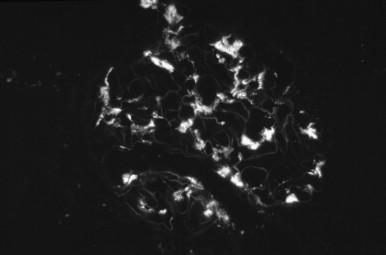
Subepithelial humps (dome-shaped, dense immune deposits) are characteristic on electron microscopy. They are prominent in the first month in epithelial slit pores, associated with nephrotic range proteinuria and persist for one to two months. Their remnants appear as electron-lucent areas. Subendothelial, mesangial and intramembranous deposits are often present and persist after resolution of the humps.
The latent period after infection is usually 1–3 weeks after pharyngitis and 3–6 weeks after skin infection. Shorter latent periods suggest an alternative diagnosis. Often a source of infection is not identified. The acute nephritic syndrome usually resolves within a week in children but takes longer in adults, especially those with crescentic GN or nephrotic syndrome. Recurrent episodes are uncommon, however repeated bouts of hematuria may occur during the initial episode. The disease does not usually recur in transplants, although de novo disease has been observed.
The laboratory findings provide clues but are not diagnostic. Hematuria, dysmorphic RBCs, and proteinuria are always present, casts are common, and pyuria may be observed in patients with severe inflammation. Nephrotic syndrome occurs in 5% of patients at initial presentation, and is sometimes present with resolution of disease. The GFR is typically reduced, and 25% have a serum creatinine >2 mg/dl. Throat or skin cultures may be positive in affected individuals. C3 and CH50 levels are significantly depressed early (>90%) but return to normal at one month. C4 and C2 are normal. High and persistent titers of C3 nephritic factor suggest MPGN. Hypergammaglobulinemia, cryoglobulinemia and Rheumatoid factor activity may be present but are not diagnostic, whereas Streptozyme antibodies are frequently positive, although also not diagnostic. Antibiotic therapy often prevents the rise in antibody titer but not the disease.
Less than 0.5% die of the initial disease and less than 2% die later from disease or develop ESRD. Children have a better prognosis than adults, and patients older than 40 years with RPGN have the worst prognosis, although their outcome is better than with other forms of RPGN. There is no difference in outcome between epidemic and sporadic forms. Urinary and histologic abnormalities may persist for years, and persistent, heavy proteinuria and/or decreased GFR carry a worse prognosis.
Therapy is symptomatic, with an emphasis on control of blood pressure and edema. Steroids, immunosuppressive agents, and/or plasmapheresis are generally not indicated, although a short course of steroids may be indicated with crescentic disease (i.e., RPGN). Specific therapy for streptococcal infections is essential and includes treatment of both the patient and any infected family member or close personal contact, to limit spread, e.g., Penicillin G 250 mg q.i.d. or erythromycin 250 mg q.i.d. for 7–10 days. During epidemics, empirical prophylactic treatment of close contacts and family members is recommended.
Anti-GBM disease may occur as a disease limited to the kidney or as part of a pulmonary-renal syndrome (Goodpasture’s syndrome). The syndrome is rare accounting for approximately 1–2% of all GN and 10–20% of RPGN. Peak incidence occurs in a bimodal distribution in the third and sixth decades, with male predominance in younger patients. Lung hemorrhage is more common in younger men, smokers and individuals with pulmonary disease, and less common in blacks.
Genetic susceptibility is suggested by occurrence of disease in siblings and twins, and analysis of MHC class II genes demonstrated that some confer susceptibility, while others confer resistance. There is a strong association with HLA-DR2 (and DR15, a subspecificity of DR2), DRB1*1501 and DRB1*1502 and a negative association with DR7 and DR1. Clearly, additional factors play a role since approximately one third of Caucasians have the DRB1*1501 allele. An environmental trigger is suggested by temporal and geographic clustering, and some have developed disease after prolonged hydrocarbon exposure. A case control study in the North of England suggested that occupational exposure to petroleum-based mineral oils led to higher anti-GBM antibodies. Cigarette smoking has also been associated with the disease, and pulmonary hemorrhage is more common in smokers than in non-smokers.
The onset of either pulmonary inflammation or nephritis may be linked to inflammation; 10% of patients with ANCA-mediated vasculitis will develop anti-GBM antibodies, and there are case reports of anti-GBM disease in patients with membranous nephropathy. These reports suggest that glomerular disease may lead to release of α3(IV) collagen, and initiate an autoimmune response in susceptible individuals.
Anti-GBM antibody-mediated disease may occur following renal transplantation in patients with Alport syndrome, as these patients lack α3, α4, α5 type IV chains. Although most patients have a mutation in the coding region for α5(IV), expression of the α3α4α5 complex requires all three chains. These individuals only express the fetal form containing the α1, α2 chains, which is more sensitive to proteolysis and linked to progressive renal failure. Following transplantation with exposure to α3, some patients develop anti-α3(IV) antibodies, presumably due to “foreign” antigen exposure, however, nephritis is uncommon in the transplanted kidney, perhaps because of ongoing immune suppression.
The Goodpasture antigen: α3(IV) collagen . Collagen IV is composed of six distinct α chains (α1–α6); each chain contains three domains: a short 7S domain at the N-terminus, a non-collagenous domain (NC1) at the C- terminus, and a long collagenous domain in the middle. The chains assemble into three sets of triple helical protomers: α1α1α2, α3α4α5 or α5α5α6. While the α1 and α2 have a wide distribution, the expression of α3α4α5 is restricted to basement membranes in glomeruli, alveoli, seminiferous tubules, choroid plexus, cochlea and retina. Three dimensional and quaternary organization analyses of the alpha chains revealed head to head association of 2 protomers at the C-terminal, forming an NC1 hexamer. In addition, association of four triple helical 7S domains at the N-terminus forms a tetramer. Supercoiling and looping of the triple helixes and disulfide cross-links between triple helical domains further contribute to the meshwork.
Analysis of antibodies from patients with anti-GBM disease established the non-collagenous domain of the α3 chain (α3 IV NC1) as the autoantigen. Detailed mapping revealed that two conformational epitopes within the N-terminal part of NC1 region (designated E A and E B ) are major targets and account for approximately 90% of autoantibody activity. These epitopes are sequestered at the interface between NC1 domains and are relatively inaccessible to autoantibodies. However, when the hexamer structure is denatured, the epitopes are exposed for autoantibody binding. Thus, it has been postulated that “two hits” are required for disease: autoantibody production and exposure of the autoantigen. This may account for the lack of nephritis in some patients with circulating antibodies. Nevertheless, human anti-GBM antibodies have a high affinity for α3(IV) NC1; they bind rapidly to their target antigen and remain tightly bound. This property contributes to both the rapidity of disease onset and treatment resistance, once GFR is significantly impaired.
Insights into the pathogenesis have also been derived from animal models. Immunization of normal mice with either recombinant or native antigen induces nephritis, however not all strains are susceptible. Disease in rodents is MHC-dependent and both T and B cell responses are required for severe disease expression, although transfer of antibodies alone is capable of inducing nephritis. Nevertheless, T cells are required for severe disease. Transfer of α3(IV)-specific CD4 T cells induce nephritis in normal mice, and Th1-related cytokines augment nephritis, whereas Th2 cytokines have a protective effect.
The light microscopic findings are typical of crescentic GN. The majority of patients (>95%) have crescents at the time of biopsy, most often involving over 50% of glomeruli. Tubulointerstitial nephritis is often present. Intense, diffuse linear staining for IgG along the GBM is characteristic ( Figure 82.2 ), and rarely IgA is found. Linear TBM staining may be present. C3 deposits are often found in a discontinuous, linear or granular pattern. In the lung, there may be patchy IgG staining, which can be missed, although erythrocytes within disrupted alveoli and hemosiderin-laden macrophages should raise suspicion.
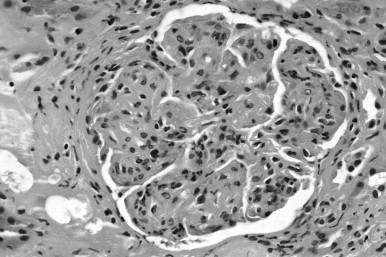
Abrupt onset of renal failure due to rapidly progressive GN is typical. Rarely, patients have a more insidious course with mild symptoms and slow progression over months. Systemic symptoms suggest the possibility of a coexisting vasculitis, whereas, acute onset of hemoptysis raises suspicion of Goodpasture’s syndrome. The pulmonary hemorrhage may be life threatening, leading abruptly to respiratory failure, although some patients have a subacute presentation with only fleeting infiltrates on chest x-ray. Unexplained anemia and heme-positive stools may occur after hemoptysis and swallowing blood.
Laboratory findings are typical of acute GN with proteinuria in the non-nephrotic range (<3 gm/day). GFR is typically reduced at presentation and rapidly deteriorates. Circulating anti-GBM antibodies can be detected in over 90% of cases (i.e., by ELISA), and Western blotting is confirmatory (2–4% false negative). One third of patients also have anti-neutrophil cytoplasmic antibodies (ANCA), with the majority as P-ANCA (i.e., vs. myeloperoxidase MPO). These “double positive” patients may develop small vessel vasculitis in organs other than the kidney and lung, and vasculitis may recur after resolution of anti-GBM disease.
Untreated, the prognosis is dismal, with death from pulmonary hemorrhage or progressive renal failure prior to the introduction of treatment with corticosteroids, cyclophosphamide and plasma exchange (i.e., patient survival <50%: ESRD >90%) ( Table 82.6 ). Patient and renal survival rates have since improved with early recognition and prompt therapy. Patients with an initial creatinine of <6 mg/dl (500 µmol/L) generally have a good prognosis if treated with plasma exchange and immunosuppression, whereas those with a creatinine of >6 mg/dl have a greater likelihood of both ESRD and death. Dialysis-dependent patients are unlikely to recover renal function, particularly if either crescents involve 100% of the glomeruli or there is extensive interstitial fibrosis. Aggressive therapy should either be withheld or abbreviated in these patients, as the risks of long-term immunosuppressive therapy outweigh the likelihood of benefit. There are exceptions. A short trial of aggressive therapy may be considered in younger patients with evidence of acute deterioration (e.g., non-oliguric, early active crescent formation) and limited fibrosis on biopsy, since some of them respond to treatment.
| Age: | Children>Adults (5%<2y; 5–10% >40y) |
| Sex: | Male>Female |
| Site of Infection: | Pharynx (temperate zones); Skin (tropics) |
| Clinical Features | |
| edema | 85% |
| gross hematuria | 30% |
| back pain | 5% |
| oliguria (transient) | 50% |
| hypertension | 60–80% |
| nephrotic syndrome | 5% |
| Laboratory | |
| Urinalysis: | proteinuria, hematuria, casts: 100% |
| Nephrotic range proteinuria: | ~10% over course of disease |
| Serum Creatinine | ≥2 mg/dl –25% |
| Streptococcal antibody profile (streptozyme): | |
| >95% positive in patients with pharyngitis | |
| 80% positive in patients with skin infections | |
| 5% false positive rate | |
| early antibiotic Rx prevents antibody response | |
| C3, C4 and/or CH50 depressed in >90% | |
| Hypergammaglobulinemia –90% | |
| Cryoglobulinemia –75% | |
| Oral cyclophosphamide * (2–3 mg/kg/day) OR |
| IV cyclophosphamide (0.5 g/m 2 BSA) ** |
| IV methylprednisolone (7 mg/kg/day for 3 days) |
| Prednisone 1 mg/kg/day after IV methylprednisolone *** |
* rounded down to the nearest 50 mg; reduced to 2 mg/kg/day in patients over 55 y
** for 4–12 months after antibody titers negative; in patients with higher risk for drug toxicity, azathioprine may be substituted as maintenance therapy
The rationale for plasmapheresis is removal of pathogenic antibodies and other inflammatory mediators. Despite widespread use, support for efficacy is limited. The standard of care is daily or alternate day 4-liter plasma exchanges for two weeks, with the frequency and duration determined by reduction of anti-GBM antibody titers and clinical response. Lung hemorrhage is an indication for plasmapheresis regardless of the presence and/or severity of renal failure. Corticosteroids and immunosuppressive therapy are required to control the ongoing inflammation and prevent new antibody formation.
Cyclophosphamide is usually continued for 6–12 months, but in patients with higher risk for drug toxicity, azathioprine may be substituted as maintenance therapy. “Double positive” patients (+ANCA and anti-GBM) present special issues. The patients should receive the same initial treatment, although since their course is more typical of ANCA-associated vasculitis (see Chapter 83 ), they usually require longer-term maintenance immunosuppression. Those who are dialysis-dependent at presentation, should be considered for a trial of immunosuppression, as some studies suggest that the presence of ANCA is associated with better outcomes, despite an initial need for dialysis, although not all reports have been confirmatory.
Kidney transplantation is an option for patients who have progressed to end stage renal disease. Although linear deposition of IgG along the GBM may be seen in up to 50% of transplanted kidneys, recurrence of nephritis is unusual, unless transplantation is performed in the presence of circulating antibodies. Current practice is to delay transplantation for six months after the antibody levels have become undetectable, and this approach results in a 1-year renal survival rate of greater than 90%.
Initially thought to be a benign form of recurrent hematuria associated with mesangial proliferative GN and IgA deposition, it is now recognized that the clinical and pathologic presentations are diverse, and it may lead to end stage renal disease. Most cases are idiopathic, but there is an association with a variety of autoimmune, infectious and chronic inflammatory diseases ( Table 82.7 ).
| GASTROINTESTINAL |
| Celiac disease/gluten enteropathy |
| Inflammatory bowel disease (Crohn’s disease, ulcerative colitis) |
| Chronic liver disease (alcoholic and nonalcoholic cirrhosis) |
| RHEUMATIC |
| Ankylosing spondylitis |
| Reiter’s syndrome |
| Rheumatoid arthritis |
| Sicca syndrome |
| Uveitis |
| INFECTION |
| Human immunodeficiency virus |
| Leprosy |
| Toxoplasmosis |
| Yersinia enterocolitica enteritis |
| Malignancy |
| IgA monoclonal gammopathy |
| Lung cancer |
| Mycosis fungoides |
| Pulmonary Disease |
| Pulmonary hemosiderosis |
| Dermatitis |
| Dermatitis Herpetiformis |
| Psoriasis |
| VASCULITIS |
| Henoch-Schonlein Purpura |
| Behcet’s syndrome |
IgAN is the most common primary GN worldwide with geographic variation, (30–40% Asia; to 5–10% North America). The differences are likely due to variations in the actual incidence, screening practices and indications for renal biopsy. It is rare in Blacks and more common in Caucasians and Native Americans (Zuni and Navajo tribes). The disease is typically diagnosed in young adults in the second and third decades of life, and it affects males more commonly than females .
The precise etiology is unknown, although a variety of factors contribute to the pathogenesis. The key element common to idiopathic and secondary forms appears to be decreased glycosylation of IgA. In normal human sera, IgA1 exists as a monomer or as a polymer, whereas IgA2 is mainly found as a monomer. Patients who develop IgA nephropathy have reduced galactosylation of polymeric IgA1, the fraction of polymeric IgA (or IgA complexes) is increased, and there is overrepresentation of IgA1λ. There is also an exaggerated response to infectious agents or other stimuli by mucosal lymph, although a specific environmental antigen has not been identified. Many patients have reduced production of polymeric IgA1 within the mucosal immune compartment, but increased numbers of polymeric IgA1 plasma cells in the bone marrow is consistent with systemic involvement.
Nevertheless, increased IgA levels alone are insufficient to cause disease, since patients with other diseases associated with increased serum IgA (e.g., human immunodeficiency virus infection (HIV), hepatobiliary disease and IgA secreting myeloma) infrequently develop nephritis. Thus, either the circulating IgA and IgA-IC among IgAN patients differ qualitatively, or the renal response to IgA deposition is different. There is evidence for both of these postulates.
IgA1 has heterogeneous O-glycan moieties in its hinge region, and serum IgA1 from IgAN patients demonstrate altered glycan side chains, with reduced terminal galactose in O-linked oligosaccharides. This incomplete galactosylation exposes the terminal sugar, N-acetyl-D galactosamine (GalNAc), generating neo-epitopes that are recognized by naturally occurring IgG and IgA1 antibodies specific for GalNac. It has been suggested that this leads to immune complex formation. Additionally, reduced galactosylation results in non-covalent self-aggregation with formation of IgA1-IgA1 complexes. This defect is restricted to IgA1 (rather than due to generalized failure of O-glycosylation), and reduced expression or function of the enzyme, core β1,3 galactosyltransferase (C1β3GalT1) that promotes addition of Gal to GalNAc residues, may be responsible. This enzyme is co-dependent on C1β3 galT1specific molecule (cosmc) for its stabilization. In the absence of cosmc, there is a decrease C1β3GalT1 which leads to decreased glycosylation. Another enzyme that can lead to less glycosylation is N-acetyl galactosamine-specific α-2,6 sialyltransferase (ST6GalNacII). If this enzyme acts first on polymeric IgA, then C1β3GalT1 cannot properly glycosylate IgA. In support of this hypothesis, one group reported decreased activity of this enzyme in circulating B cells in IgAN patients.
Other circulating immune complexes have also been implicated, including those containing IgA rheumatoid factors, IgA-fibronectin and IgA-soluble FcRI receptors (CD89), although their pathogenic role is uncertain. Nevertheless, decreased clearance of IgA-containing complexes may contribute to pathogenesis, and this may be especially relevant in patients with liver disease. In this regard, hepatic asialoglycoprotein receptor (ASGP-R) and the myeloid FcRI receptor/CD89 are involved in IgA catabolism and clearance of IgA1 immune complexes. Abnormal O-glycosylation or antibodies bound to GalNac may prevent the interaction of IgA with hepatocyte receptors (and monocytes and neutrophils), and therein decreased clearance occurs.
Cellular immunity may also contribute to pathogenesis, with Th2 cytokines (e.g., IL-4 and IL-5) influencing IgA galactosylation. In a mouse IgAN model, Th2 bias in response to mucosal infection regulated glycosylation of IgA, and promoted glomerular IgA deposition. Lymphocytes from patients with IgAN produce more IL-4 in response to mitogenic stimulation than controls, and this appears to be more pronounced in patients with severe renal dysfunction. Furthermore, clinical remissions have been associated with more normal IL-4 responses.
Activation of mesangial cells, through cytokine priming, is most likely required for inflammation. Nevertheless binding of polymeric, Gal-deficient IgA1 (possibly mediated by transferrin Tfr/CD71 and Fcα/μ receptors) may directly activate mesangial cells. A prominent role for IL-6 has also been proposed, and this may be especially relevant to patients with liver disease. IL-8, PDGF, TNFα, TGF-β and MCP-1 may also have important roles. In any case, either polymeric IgA or aberrantly glycosylated IgA are very efficient at directly activating the complement cascade, either via the alternative or lectin pathways, and this may play a major role. Podocyte injury may be involved in progressive disease with proteinuria, as polymeric IgA stimulates podocytes to produce TNF-α.
Several findings suggest that genetic factors contribute to pathogenesis, including familial clustering and a higher risk of disease in identical twins. In a large kindred study, linkage analysis revealed an association with 6q22–23 (IgAN1), although since only 60% of patients had IgAN1, other genes are likely involved. Other proposed candidates include MHC, uteroglobin, selectin and angiotensin-1 converting enzyme genes (DD genotype), however the results have been conflicting. Interestingly, a genome-wide search in the ddY murine model revealed that syntenic regions of IgAN1 and selectin genes are major genetic determinants for IgAN.
Immunofluorescence (IF) demonstrates prominent deposits of IgA in a diffuse, granular pattern, predominantly within the mesangium ( Figure 82.3 ), and occasionally in the glomerular capillary wall, typically accompanied by C3 and IgG, and less frequently by IgM. There is often a predominance of λ light chains. Light microscopic findings are variable. Glomeruli may show mild lesions without mesangial expansion or limited mesangial cell proliferation, mesangioproliferative GN, focal or diffuse proliferative GN, crescents, chronic sclerosing GN, or rarely an MPGN pattern. Electron microscopy typically reveals electron dense deposits, predominantly within the mesangium, although capillary wall deposits are common in more severely affected individuals.
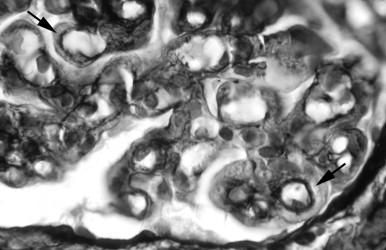
IgAN has many clinical presentations ( Table 82.9 ). Recurrent episodes of macroscopic hematuria are more common in younger patients. These episodes often occur within 2–3 days of an upper respiratory tract or other infection. Loin pain may accompany the hematuria, (i.e., due to renal capsular swelling. In 30–40% of patients, the disease is asymptomatic with persistent or intermittent microscopic hematuria or proteinuria discovered incidentally. Acute renal failure occurs in less than 5% due to either crescentic GN, renal tubular obstruction by red blood cells or acute tubular necrosis. Nephrotic syndrome is a less common presentation, although given IgAN’s overall prevalence, it accounts for a significant fraction of adults with idiopathic nephrotic syndrome (i.e., 20–25%).
| Summary of Key Pathological Features |
|---|
|
| Recurrent episodes of gross hematuria (i.e., following infection) |
| Asymptomatic microscopic hematuria |
| Acute GN |
| RPGN with acute renal failure (<5%) |
| Nephrotic syndrome |
Overall prognosis is variable and depends on the severity of clinical and pathologic findings at presentation. It has been estimated that ESRD occurs in 15 percent of cases at 10 years and 20–40% percent at 20 years, although this likely reflects selection of patients with more severe disease. Some patients have a slow progressive decline in renal function over 10–20 years. Patients with non-nephrotic proteinuria and normal GFR at presentation progress more slowly (e.g., 1–3 ml/min/year). Elevated serum creatinine and heavy proteinuria at either presentation, or within the first year of diagnosis are independent predictors of poor outcome; hypertension, glomerulosclerosis, and interstitial fibrosis are others.
Secretory IgA, urinary complement factor H/urine creatinine ratio, serum galactose deficient IgA (HAA-IgA) and urinary ratio of epidermal growth factor and monocyte chemotactic peptide-1 are being investigated as potential biomarkers. No therapeutic approach has consistently been shown to slow progression, and variations in pathogenesis, pathology, clinical severity, co-morbid conditions and other factors contribute to this limitation. Clinical trials have compared conservative therapy, renin angiotensin aldosterone system (RAAS) blockade, and various immunosuppressive strategies. The consensus is that patients with normal renal function, (including <1 gm of proteinuria, minimal lesion on biopsy, and blood pressure of 120/80) do not require treatment. Patients with hypertension, proteinuria (>1 gm/day), reduced GFR, or more severe pathological lesions on biopsy may require treatment. The specific approach remains somewhat controversial. Multiple studies have shown RAAS inhibition
|
(e.g., with ACEI or ARB) slows progression of the disease. Although the combination may have additional benefits, acute renal failure may complicate this approach. Fish oils, rich in omega 3 fatty acids (ω-3PUFA), eicosapentanoic acid (EPA) and docosahexanoic acid (DHA) may provide anti-inflammatory effects and retard renal progression by competing with arachidonic acid to produce biologically less effective prostaglandins and leukotrienes, and by decreasing platelet aggregation, although clinical trials of efficacy have produced conflicting results. Nevertheless, given the possible benefit and lack of toxicity, high dose fish oil therapy in combination with ACEI/ARB therapy in patients with proteinuria (>1 g/day) and/or mildly impaired renal function is reasonable.
The efficacy of high dose steroids and other immunosuppressive agents is not certain. One prospective multi-center trial randomized IgAN patients (SCr <1.5 mg/dl, proteinuria 1.0–3.5 g/d) to either six months of steroid treatment or supportive therapy. At 6 and 10 years, there was a lower incidence of the doubling of serum creatinine in the steroid group, and this was associated with a decrease in proteinuria. Thus, steroids may be warranted in IgAN patients with heavy proteinuria and relatively normal renal function. Patients with either nephrotic syndrome and histologic findings characteristic of minimal change disease or clinical and pathologic features of RPGN may also benefit from steroid therapy. Other immunosuppressive approaches have been inconclusive. Similarly, removal of the palatine tonsils to reduce serum IgA levels and limit progression has not been associated with preservation of renal function.
Immunohistologic recurrence develops in as many as 60% of allografts by 10 years and 5–10% of affected allografts are lost to progressive disease. Contemporary immunosuppression regimens using MMF have not altered recurrence rates.
MPGN or mesangiocapillary GN may be idiopathic or associated with systemic diseases. Pathologically, they share light microscopic features including glomerular capillary wall thickening, hypercellularity and matrix expansion ( Figure 82.4 ). MPGN is further classified as type I, II or III, based on IF and EM patterns. This section focuses on primary or idiopathic forms of the disease.
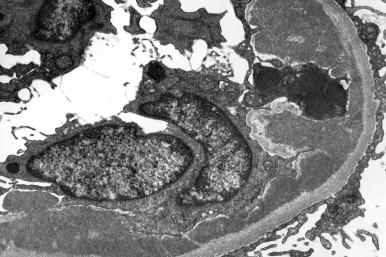
Overall these forms represent less than <10% of primary glomerular disease GN, although they are somewhat more prevalent in children.
MPGN I is characterized by subendothelial and mesangial immune deposits, with IgG and complement deposition predominating. Diffuse thickening of capillary walls is typical, and the loops often have a double-contoured or “tram track” appearance when stained with silver methenamine or periodic acid-Schiff ( Figure 82.5 ). Widespread electron-dense deposits in subendothelial sites are the hallmark of type I disease ( Figure 82.6 ). The hallmark of MPGN type II is the presence of electron dense deposits within the lamina densa layer of the GBM that are often visible by conventional eosin and PAS stains (hence the designation Dense Deposit Disease). The dense intramembranous deposits seen by electron microscopy are diagnostic ( Figure 82.7 ) and may involve tubular and vascular basement membranes in the kidney, Bruch’s membrane in the eye, and sinusoidal membranes in the spleen. The deposits may also be seen within the mesangium and within the basement membranes of Bowman’s capsules and tubules. The chemical composition of the electron dense deposits is not known, but they stain with thioflavin T and bind lectin wheat germ agglutinin, suggesting that they are composed of N-acetyl-glucosamine, glycoproteins and lipids rich in unsaturated fatty acids. Immunofluorescence reveals intense staining of C3 along capillary walls and within the mesangium. Absence of immunoglobulins is a distinguishing feature of Type II MPGN. By contrast Type III MPGN, also called the Burkholder variant, displays features of MPGN type I and membranous nephropathy, with subepithelial, subendothelial and mesangial deposits. Successive generation of subendothelial and subepithelial deposits disrupt the basement membrane, and concurrent formation of new lamina densa material are often observed.
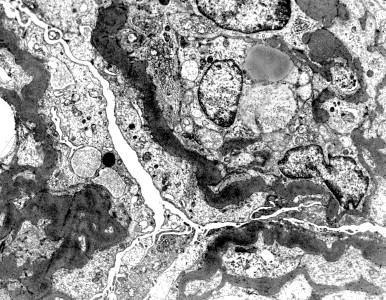
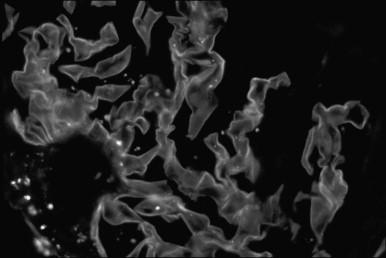
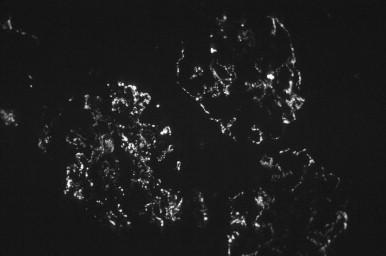
Local activation of the complement cascade is operative in all forms. Catalyst destabilization (e.g., through either acquired antagonism or deficiency in the inhibitory pathway), results in unopposed complement activation in glomeruli. Hypocomplementemia results from local consumption and/or circulating autoantibodies against individual complement components (i.e., nephritic factors). Three nephritic autoantibodies have been commonly described in MPGN type 1, including: (1) C4Nef, an IgG that stabilizes the C3 convertase, C4b2a, thereby preventing the decay of 2a from C4b2a; (2) C3Nef (see below); and (3) NFt, an autoantibody against C3bBbP that activates the terminal pathway. Their precise pathogenic role is uncertain, as they are occasionally detected in either unrelated diseases (e.g., post-streptococcal GN, SLE, meningococcal meningitis) or healthy individuals.
MPGN has variable presentations, from microscopic hematuria and sub-nephrotic proteinuria (35%), to nephritic syndrome with mild renal impairment (35%), to an aggressive glomerulonephritis (20%) with rapidly deteriorating renal function, heavy proteinuria, and RBC casts (10%). Laboratory findings often display decreased complement levels [C3, C4, and total complement (CH50)], depending on the variety of MPGN ( Table 82.11 ).
| Type I, Immune Complex Formation with Classical Pathway Activation |
|---|
| Antibody Antigen Complexes not well Defined (i.e., in those not Associated with Infections or Cancer) |
| Three circulating nephritic autoan tibodies commonly described, although their pathogenic role is uncertain as they may be found in other diseases: |
|
| Type II Dense Deposit Disease (by EM; IF C3, no Ig) |
| Unregulated Renal Complement Activation |
| 1) IgG nephritic factors C3 nephritic factor (C3Nef), 80% patients |
| Autoantibodies vs. C3bBb (rate limiting C3 convertase of the alternative pathway |
| Prolongs half-life of C3 convertase preventing physiologic regulation and inactivation by factors H and I, leading to continued activation of C3 (fig 1b). Inflammation may dependent of C5a activation, instead of C5b-9 |
| 2) Factor H (fH) dysfunction or deficiency. |
| Acquired vs. Hereditary |
| 3) Profoundly low plasma C3, variable C4 levels (alternative pathway) |
| Type III Type I plus Subepithelial Immune Deposits |
| low C3 levels, normal C4 |
Control of hypertension and proteinuria reduction are key, and focus should be on identifying and treating secondary causes of the lesions. For idiopathic disease, treatment is based on disease severity. Patients with sub-nephrotic proteinuria and preserved renal function are treated conservatively. Patients with impaired renal function and/or nephrotic proteinuria can undergo a trial of prednisolone (1 mg/kg/d) for proteinuria reduction. If a response is noted, steroids can be continued at the minimally-effective dose. If there is no response after three months, steroids should be stopped, and a trial of a calcineurin inhibitor or mycophenolate mofetil can be attempted. Patients with rapidly declining renal function, or with crescents on biopsy should be treated as those with other forms of RPGN.
Thrombotic microangiopathy (TMA) is characterized by the syndrome of microangiopathic hemolytic anemia, thrombocytopenia, and variable organ dysfunction due to platelet thrombosis in the microcirculation, which can mimic acute GN. Depending on the predominant distribution of organ involvement, pathologically identical, but clinically separable entities have been designated as: Hemolytic-Uremic Syndrome (HUS) and Thrombotic Thrombocytopenic Purpura (TTP). Since their pathophysiology overlaps, both topics are presented.
| Nephrotic syndrome plus microscopic hematuria (50–60%) |
| Acute GN (15–30%) |
| Asymptomatic urinary abnormalities (i.e. proteinuria and hematuria. 20–30%) |
| Recurrent macroscopic hematuria (<10%) |
| Hypertension may be mild or severe |
| Note that MPGN Type II often presents with acute nephritis and/or macroscopic hematuria, MPGN Type III often presents with more insidious onset |
| MPGN III low C3 levels, normal C4 |
| Light microscopy (similar in all forms) |
| Mesangial expansion and capillary wall thickening [i.e., termed, mesangiocapillary GN ]. Capillary loops with double-contoured or “tram track” appearance when stained with Jones silver methenamine or periodic acid Schiff (PAS), +/- nodular glomerulosclerosis pattern |
| Immunofluorescence/electron microscopy patterns distinguish the subtypes type I, prominent C3 capillary walls and mesangium IgG>>IgM C1q +/− C4 |
| EM - subendothelial deposits - type I hallmark; intramembranous dense deposits – type II hallmark ). |
| Increased matrix material (subendothelial) |
| This material is separated from the native GBM by interposed cytoplasmic extensions of mesangial cells and/or infiltrating macrophages, and is responsible for the ‘tram track’ appearance of the basement membranes seen by light microscopy. |
Typical HUS commonly affects children under five, is characterized by moderate to severe renal involvement, and is self-limited. It is caused by specific serotypes of E. coli or other bacteria that produce Shiga-like toxin. Atypical HUS may be familial or sporadic. The familial forms are associated with genetic abnormalities in complement system proteins. The sporadic forms are often triggered by drugs, malignancy, infection or autoimmune disease that lead to dysregulation of complement system proteins ( Table 82.15 ).
| Light microscopy is similar in all forms of MPGN |
| mesangiocapillary GN |
| -mesangial proliferation and matrix expansion |
| -capillary wall thickening (double contour 2° to immune deposits) |
| -double contour appearance of capillary loops (2° to immune deposits) |
| IF | |
|---|---|
| Type 1 Type II | Type III |
| IgG±IgM None | IgG±IgM C1q, C4, C3 (SEndo/Mes) |
| EM | |
| SEndo/Mes Dense Deposits (EM) | SEndo/Mes/Subepith |
| Scleroderma renal crisis |
| Anti-phospholipid syndrome |
| Pregnancy |
| HELLP Syndrome |
| Postpartum HUS |
| Human Immunodeficiency Virus (HIV) |
| Malignancy |
| Drugs |
| Mitomycin |
| Tamoxifen |
| Cisplatin |
| Ticlopidine |
| Quinine |
| Interferon-α |
| Calcineurin Inhibitors |
| Rifampin |
| Metronidazole |
| Renal Transplantation |
| De novo disease |
| Recurrence of TMA |
TTP occurs in adults and typically manifests with more neurologic sequelae and variable renal involvement. Prompt recognition of these disorders is essential, as delay in therapy may lead to organ failure or death (i.e., with TTP).
The TMAs occur in 1–4 cases per 1,000,000 people, although it has been reported more frequently in patients with malignancy, HIV infection, or various drug exposures ( Table 82.15 ). As previously mentioned, acquired HUS may be associated with Shiga toxin-producing E. coli (or other bacterial) infection and commonly affects infants and children infected with the O157:H7 strain.
Become a Clinical Tree membership for Full access and enjoy Unlimited articles
If you are a member. Log in here